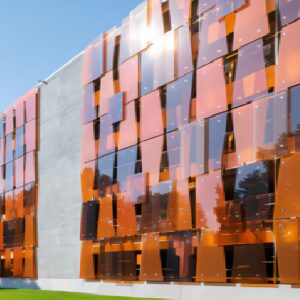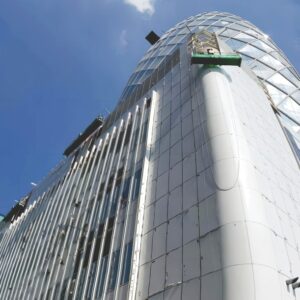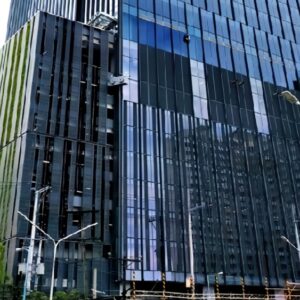English Content on Aluminum Alloy 5052
Introduction
Aluminum alloy 5052 is a versatile and widely-used alloy known for its excellent corrosion resistance, strength-to-weight ratio, and workability. It belongs to the “non-heat treatable” family of alloys, which means that it cannot be hardened through heat treatment.
Properties
The properties of aluminum alloy 5052 are as follows:
| Property | Value |
|—|—|
| Density | 2.68 g/cm³ |
| Tensile strength | 225-260 MPa |
| Yield strength | 115-135 MPa |
| Elongation | 15-20% |
| Hardness | 60-70 HRB |
| Electrical conductivity | 33% IACS |
| Thermal conductivity | 202 W/(m·K) |
| Corrosion resistance | Excellent |
Applications
Due to its favorable properties, aluminum alloy 5052 is used in a wide range of applications, including:
- Marine: Boat hulls, superstructures, and deck plates
- Automotive: Car bodies, panels, and trim
- Construction: Roofing, siding, and building facades
- Consumer products: Appliances, cookware, and electronic housings
- Industrial: Equipment frames, tanks, and piping
Comparison with Other Alloys
To provide a better understanding of the characteristics of aluminum alloy 5052, here is a comparison with two other commonly used alloys:
| Feature | 5052 | 6061 | 7075 |
|—|—|—|—|
| Heat treatable | No | Yes | Yes |
| Strength | Medium | High | Very high |
| Corrosion resistance | Excellent | Good | Fair |
| Weldability | Good | Fair | Poor |
| Machinability | Excellent | Good | Fair |
Advantages and Disadvantages
Advantages:
- Excellent corrosion resistance
- Lightweight and durable
- Good weldability and machinability
- Non-magnetic
- Recyclable
Disadvantages:
- Lower strength than heat-treatable alloys
- Cannot be hardened through heat treatment
- Susceptible to stress corrosion cracking in certain environments
Conclusion
Aluminum alloy 5052 is a versatile and reliable material that combines excellent corrosion resistance, strength-to-weight ratio, and workability. Its wide range of applications in various industries demonstrates its adaptability and value.
Introduction
Introduction
Aluminum alloy 5052 is a versatile and widely used alloy in the aluminum family. It is composed primarily of aluminum, with additions of magnesium (2.2-2.8%) and chromium (0.15-0.35%). This combination of elements provides aluminum alloy 5052 with a unique set of properties that make it suitable for various applications in industries such as construction, transportation, and marine.
Definition of Aluminum Alloy 5052
Aluminum alloy 5052 is a non-heat-treatable aluminum alloy. It belongs to the 5XXX series of aluminum alloys, which are known for their high strength and corrosion resistance. Aluminum alloy 5052 is characterized by its good weldability, formability, and machinability.
Significance and Applications
Aluminum alloy 5052 is highly valued for its combination of properties, making it an ideal choice for a wide range of applications. Some of its key properties include:
- High strength: Aluminum alloy 5052 offers a high strength-to-weight ratio, making it suitable for structural applications where strength and durability are required.
- Excellent corrosion resistance: Aluminum alloy 5052 has excellent corrosion resistance, making it suitable for use in marine environments and other corrosive conditions.
- Good weldability: Aluminum alloy 5052 is easily welded using various welding techniques, including MIG, TIG, and spot welding.
- Good formability: Aluminum alloy 5052 can be easily formed into complex shapes using cold forming techniques such as bending, rolling, and drawing.
- Good machinability: Aluminum alloy 5052 can be easily machined using conventional machining techniques.
Due to its desirable properties, aluminum alloy 5052 is extensively used in various industries, including:
- Construction: Building facades, roofing, siding, and structural components.
- Transportation: Automotive parts, aircraft components, and marine vessels.
- Industrial: Chemical processing equipment, heat exchangers, and storage tanks.
- Consumer products: Food and beverage containers, cookware, and appliances.
Applications Comparison
To illustrate the versatility of aluminum alloy 5052, the following table compares its properties and applications to other aluminum alloys:
| Aluminum Alloy | Strength | Corrosion Resistance | Weldability | Formability | Machinability | Primary Applications |
|—|—|—|—|—|—|—|
| 5052 | High | Excellent | Good | Good | Good | Construction, transportation, marine |
| 6061 | Very high | Good | Excellent | Good | Good | Automotive, aerospace, engineering |
| 7075 | Extremely high | Moderate | Good | Poor | Poor | Aerospace, high-performance components |
| 3003 | Moderate | Excellent | Good | Excellent | Excellent | Food and beverage containers, consumer products |
Conclusion
Aluminum alloy 5052 is a highly versatile and widely used aluminum alloy that offers a unique combination of strength, corrosion resistance, weldability, formability, and machinability. Its diverse range of applications makes it a valuable material for industries such as construction, transportation, and marine, as well as for a variety of consumer products.
Physical and Mechanical Properties
Composition and Alloying Elements
Aluminum alloy 5052 is a non-heat-treatable alloy belonging to the 5xxx series. It contains primarily aluminum (96-98%) and magnesium as its primary alloying element (2.2-2.8%). Smaller amounts of manganese (0.05-0.2%) and chromium (0.15-0.35%) may also be present.
Mechanical Strength and Hardness
Alloy 5052 exhibits moderate mechanical strength and hardness compared to other aluminum alloys. In the annealed (O) condition:
| Property | Value |
|—|—|
| Tensile strength | 160-200 MPa (23-29 ksi) |
| Yield strength | 100-130 MPa (14-19 ksi) |
| Elongation at break | 20-25% |
| Hardness (Vickers) | 60-70 HV |
Corrosion Resistance and Surface Treatments
Alloy 5052 has excellent corrosion resistance, particularly in marine environments, due to its high magnesium content. The formation of a thin, protective oxide layer on the surface enhances its resistance to corrosion. However, it is susceptible to stress corrosion cracking if exposed to certain conditions.
To improve corrosion resistance and enhance surface appearance, various surface treatments are commonly applied to alloy 5052:
| Treatment | Purpose |
|—|—|
| Anodizing | Enhances surface hardness, corrosion resistance, and wear resistance |
| Chromating | Forms a thin, protective chromate conversion coating, providing corrosion resistance |
| Painting | Protects the surface from scratches, corrosion, and fading |
| Powder coating | Provides a durable, decorative finish with excellent corrosion resistance |
Applications
Due to its combination of strength, corrosion resistance, and good weldability, aluminum alloy 5052 finds application in various industries:
- Marine and shipbuilding: Hulls, superstructures, decks
- Automotive industry: Body panels, hoods, doors
- Aerospace: Fuel tanks, aircraft skins
- Construction: Roofing, siding, gutters, window frames
- Consumer products: Appliances, furniture, lighting fixtures
Advantages and Benefits
Aluminum alloy 5052, an alloy in the 5xxx series, is widely renowned for its exceptional combination of properties, including high strength, excellent corrosion resistance, and superior formability and weldability. These advantages make it an ideal choice for a wide range of applications across various industries.
Advantages and Benefits of ALU 5052
1. High Strength-to-Weight Ratio
ALU 5052 boasts an impressive strength-to-weight ratio, making it a lightweight yet robust material. This property is critical for applications where weight reduction is essential, such as in aerospace and automotive components.
2. Excellent Corrosion Resistance
This alloy exhibits outstanding corrosion resistance, particularly in marine environments and industrial atmospheres. Its protective oxide layer effectively resists pitting, crevice, and stress-corrosion cracking, ensuring long-term durability and maintenance-free operation.
3. Formability and Weldability
ALU 5052 possesses exceptional formability, allowing it to be easily shaped into complex designs. Furthermore, it offers excellent weldability, enabling the production of strong and reliable welded joints. These characteristics make it suitable for applications requiring intricate shapes or welded assemblies.
Comparison with Other Aluminum Alloys
The table below compares ALU 5052 with other commonly used aluminum alloys:
| Alloy | Strength | Corrosion Resistance | Formability | Weldability |
|—|—|—|—|—|
| ALU 5052 | High | Excellent | Good | Excellent |
| ALU 6061 | Higher | Lower | Excellent | Good |
| ALU 3003 | Lower | Good | Excellent | Excellent |
Applications of ALU 5052
The versatility of ALU 5052 makes it applicable to a vast array of industries, including:
- Aerospace: Aircraft skins, structural components, and engine parts
- Automotive: Body panels, chassis, and suspension components
- Marine: Boat hulls, decks, and fittings
- Construction: Roofing, siding, and window frames
- Food and beverage: Food processing equipment and beverage containers
- Sporting goods: Bicycle frames, golf shafts, and fishing rods
Conclusion
ALU 5052’s exceptional properties, including its high strength-to-weight ratio, excellent corrosion resistance, and superior formability and weldability, make it an indispensable alloy for a wide range of applications. Its versatility and durability have led to its widespread use across various industries, from aerospace and automotive to construction and sporting goods.
Disadvantages and Limitations
Aluminum alloy 5052 is a popular choice for various industrial applications due to its exceptional corrosion resistance, weldability, and formability. However, like all materials, it has certain disadvantages and limitations that must be considered before its use.
1. Lower Strength
Compared to other aluminum alloys, such as 6061 or 7075, Aluminum 5052 has a lower tensile strength. This means that it is less resistant to deformation and breakage under applied loads.
2. Susceptibility to Stress Corrosion Cracking
Stress corrosion cracking (SCC) is a type of corrosion that occurs when a metal is subjected to both stress and a corrosive environment. Aluminum 5052 is susceptible to SCC in certain environments, such as those containing chlorides or other corrosive agents. SCC can lead to premature failure of the material.
Additional Considerations:
In addition to these disadvantages, other factors to consider when using Aluminum 5052 include:
- Hardness: Aluminum 5052 is relatively soft, making it susceptible to scratching and denting.
- Thermal Conductivity: Compared to other aluminum alloys, Aluminum 5052 has lower thermal conductivity, which can limit its use in applications requiring efficient heat transfer.
- Machinability: Aluminum 5052 is more difficult to machine than some other aluminum alloys, requiring specialized tools and techniques.
Comparison with Other Aluminum Alloys
The table below compares the key characteristics of Aluminum 5052 with other commonly used aluminum alloys:
| Alloy | Tensile Strength (MPa) | SCC Resistance | Applications |
|—|—|—|—|
| 5052 | 150-250 | Limited | Corrosion-resistant applications, automotive trim |
| 6061 | 200-350 | Good | Structural applications, transportation, aerospace |
| 7075 | 500-600 | Excellent | High-strength applications, aerospace, defense |
Applications and Precautions
Despite its limitations, Aluminum 5052 is still a versatile material suitable for various applications, including:
- Corrosion-resistant parts for marine environments
- Automotive trim and accessories
- Food processing equipment
- Architectural components
- Heat exchangers
When using Aluminum 5052, it is essential to take precautions to mitigate its disadvantages, such as:
- Avoiding exposure to corrosive environments
- Applying protective coatings or treatments
- Designing with stress-relieving features
- Using more robust alloys for high-strength applications
By carefully considering the properties and limitations of Aluminum 5052 and taking appropriate precautions, it can be used effectively for a wide range of applications.
Testing and Standards
ALU 5052 is an aluminum alloy widely used in various engineering applications due to its excellent corrosion resistance, moderate strength, and weldability. To ensure the quality and reliability of components made from this alloy, a rigorous testing and certification process is employed.
Mechanical Testing Methods
Tensile Testing:
- Tensile testing determines the material’s ultimate tensile strength, yield strength, elongation at break, and other mechanical properties.
- A standard specimen is subjected to a controlled tensile load until it breaks.
- The stress-strain curve obtained during the test provides valuable insights into the material’s behavior under load.
Corrosion Testing Standards
ASTM B117:
- The ASTM B117 salt spray test is a widely used method to assess the corrosion resistance of materials.
- Samples are exposed to a controlled salt spray environment for a specified duration to determine their resistance to pitting and corrosion.
- The results are reported in terms of hours of exposure before visible corrosion occurs.
Industry Specifications
Aerospace Industries Association (AIA):
- AIA standards define specifications for materials used in the aerospace industry.
- These standards include requirements for mechanical properties, corrosion resistance, and other aspects of material performance.
- ALU 5052 is commonly used in aerospace applications where light weight, corrosion resistance, and weldability are crucial.
American Society for Testing and Materials (ASTM):
- ASTM develops and publishes standards for various materials and testing procedures.
- ASTM specifications for ALU 5052 include tensile strength, yield strength, elongation at break, and corrosion resistance requirements.
- These standards are widely used in manufacturing and quality control processes across industries.
Comparison of Testing Methods and Standards
| Testing Method | Standard | Purpose |
|—|—|—|
| Tensile Testing | ASTM E8 | Determines mechanical properties such as tensile strength, yield strength, and elongation. |
| Salt Spray Test | ASTM B117 | Assesses corrosion resistance in a controlled salt spray environment. |
| AIA Specifications | AIA 017 | Establishes requirements for materials used in aerospace applications, including ALU 5052. |
| ASTM Specifications | ASTM B209 | Defines tensile strength, yield strength, elongation, and corrosion resistance requirements for ALU 5052. |
Conclusion
ALU 5052 is subject to rigorous testing and certification procedures to ensure its quality and performance. Mechanical testing methods, corrosion testing standards, and industry specifications provide a comprehensive framework for evaluating the material’s mechanical properties, corrosion resistance, and suitability for specific applications. By adhering to these standards, manufacturers can ensure the reliability and longevity of components made from this versatile aluminum alloy.
Alloy Variations and Modifications
Introduction
[alu 5052] is a widely used aluminum alloy known for its excellent corrosion resistance, weldability, and strength. It is commonly employed in marine applications, transportation, and chemical processing. To meet specific requirements, [alu 5052] can be modified through variations in temper, alloying elements, and heat treatment processes.
Temper Designations and Properties
[alu 5052] is available in various temper designations, each providing a specific combination of strength and formability.
| Temper Designation | Properties |
|—|—|
| H24 | High strength, reduced ductility |
| H32 | Moderate strength, increased ductility |
| H34 | Lowest strength, highest ductility |
| O | Annealed, soft, and easy to form |
Alloy Modifications for Specific Applications
[alu 5052] can be modified by adding specific alloying elements to enhance its properties for particular applications.
| Alloying Element | Application |
|—|—|
| Manganese (Mn) | Increased strength and corrosion resistance |
| Chromium (Cr) | Improved elevated temperature strength |
| Magnesium (Mg) | Enhanced corrosion resistance in marine environments |
| Zirconium (Zr) | Refined grain structure, increased strength |
Heat Treatment Processes
Heat treatment processes can significantly alter the properties of [alu 5052]. Common techniques include:
| Heat Treatment Process | Effect |
|—|—|
| Solution Heat Treatment (SHT) | Dissolves precipitates, increases strength |
| Aging | Hardens the alloy by forming fine precipitates |
| Annealing | Softens the alloy by removing strain |
Specific Examples of Modifications
- [alu 5083] is a modification of [alu 5052] with the addition of manganese, providing increased strength and corrosion resistance for marine applications.
- [alu 5056] incorporates magnesium, enhancing its corrosion resistance in marine environments and making it suitable for shipbuilding and offshore structures.
- [alu 5454] is a heat-treatable version of [alu 5052] that can be hardened through solution heat treatment and aging, providing both strength and formability.
Conclusion
The variations and modifications of [alu 5052] allow it to be tailored to meet the diverse requirements of different applications. By adjusting temper designations, alloying elements, and heat treatment processes, engineers can leverage the unique properties of this aluminum alloy to optimize performance and achieve desired outcomes.
Sustainability and Environmental Considerations
Recyclability and Environmental Impact
Aluminum 5052 is a high-strength, corrosion-resistant alloy that is used in various applications, including construction, transportation, and consumer products. It is known for its excellent recyclability, making it an environmentally friendly material.
The recycling process for aluminum 5052 involves melting down scrap aluminum and recasting it into new products. This process consumes significantly less energy compared to producing aluminum from raw materials, reducing greenhouse gas emissions. Additionally, aluminum is a non-toxic material that does not pose significant environmental hazards during the recycling process.
Material Selection Criteria for Sustainable Design
When selecting materials for sustainable design, several criteria should be considered to minimize environmental impact. These criteria include:
- Materials with high recycled content: Using materials with a high percentage of recycled content reduces the demand for virgin materials and conserves natural resources.
- Low embodied energy: Materials with low embodied energy require less energy to produce, transport, and process, contributing to a lower carbon footprint.
- Durability and longevity: Durable materials can withstand wear and tear over a longer period, reducing the need for replacements and minimizing waste.
- Biodegradability or compostability: Materials that can decompose or be composted at the end of their life cycle minimize landfill waste and promote soil regeneration.
- Non-toxicity: Materials that are non-toxic or have minimal environmental hazards ensure the safety of human health and ecosystems.
Aluminum 5052 and Sustainable Design
Aluminum 5052 meets several sustainability criteria for sustainable design:
- It is highly recyclable, with a recycling rate of over 90%.
- It has a relatively low embodied energy compared to other metals.
- It is durable and can withstand harsh conditions, reducing the need for replacements.
- It is non-toxic and does not pose significant environmental hazards.
In addition to these criteria, aluminum 5052 is also lightweight, which reduces transportation costs and energy consumption. Its strength and corrosion resistance make it an excellent choice for applications where durability and longevity are critical.
Conclusion
Aluminum 5052 is a sustainable material that can significantly contribute to environmental protection. Its high recyclability, low embodied energy, durability, and non-toxicity make it an environmentally responsible choice for various applications. By incorporating aluminum 5052 into sustainable design practices, we can minimize waste, conserve resources, and reduce our carbon footprint.
Case Studies and Examples
Aluminum alloy 5052 is a versatile and widely used alloy renowned for its excellent strength, corrosion resistance, and workability. Its unique properties make it a prime choice for various industries.
Successful Applications in Various Industries
- Automotive: Alloy 5052 is used in automotive parts such as engine blocks, cylinder heads, and transmission casings due to its high strength-to-weight ratio and resistance to fatigue and wear.
- Marine: In marine applications, 5052 is employed for hulls, decks, and superstructures. Its corrosion resistance and weldability make it ideal for harsh marine environments.
- Building and Construction: The alloy’s strength, durability, and ease of fabrication make it suitable for structural components, roofing, and siding.
- Food and Beverage: 5052 is approved for food contact and is commonly used in cookware, food processing equipment, and beverage containers.
- Aerospace: Due to its high strength-to-weight ratio and weldability, 5052 is utilized in aerospace applications such as aircraft skins, wing spars, and structural components.
Innovation and Advancements in Aluminum Alloy 5052 Technology
- Enhanced Strength: Recent advancements have focused on improving the strength of 5052 alloy. By optimizing heat treatment processes and incorporating advanced precipitation hardening techniques, manufacturers have achieved significantly higher yield and tensile strengths.
- Improved Corrosion Resistance: Innovations in alloy composition and surface treatments have resulted in improved corrosion resistance. 5052 alloys with enhanced chromium content and optimized surface oxide layers exhibit superior resistance to marine and industrial environments.
- Advanced Weldability: New welding technologies, such as friction stir welding (FSW) and laser welding, have significantly improved the weldability of 5052 alloy. These techniques minimize distortion and increase weld strength, expanding its applications in industries requiring high-quality welds.
- Lightweighting and Sustainability: As demand for lightweight materials grows, 5052 alloy’s high strength-to-weight ratio and recyclability make it an ideal choice for applications where weight reduction and sustainability are critical.
- Surface Finish and Aesthetics: Advances in surface treatment technologies, such as anodizing and powder coating, allow 5052 alloy to achieve a wide range of surface finishes and colors. This versatility enhances its aesthetic appeal and opens up new applications in architectural and decorative industries.
Conclusion
Aluminum alloy 5052 continues to be a vital material for various industries due to its exceptional properties and innovative advancements. Its high strength, corrosion resistance, workability, and versatility make it an indispensable choice for applications ranging from automotive and marine to construction and aerospace. As technology continues to evolve, we can expect even further enhancements and advancements in 5052 alloy, expanding its role in shaping the future of modern manufacturing and design.
Future Trends and Research Directions
Aluminum alloy 5052 is a widely used material in various industries due to its excellent properties, including high strength, corrosion resistance, and workability. As technology advances and the demand for innovative materials grows, research efforts are continuously focused on exploring new frontiers in the development and applications of aluminum alloy 5052.
Development of New Alloys and Surface Treatments
Researchers are constantly innovating to develop new aluminum alloys with enhanced properties and functionalities. For instance, the addition of alloying elements such as magnesium, copper, and manganese can improve strength, toughness, or corrosion resistance. Advanced surface treatments, such as anodizing and thermal spraying, can further enhance surface properties, providing improved wear resistance, corrosion protection, or electrical insulation.
Exploring Applications in Emerging Fields
The potential applications of aluminum alloy 5052 are expanding into new and emerging fields. In the automotive industry, it is being used for lightweight components in electric vehicles, reducing weight and improving energy efficiency. In the aerospace industry, it is considered for structural applications due to its strength-to-weight ratio and corrosion resistance. Additionally, alloy 5052 is finding uses in renewable energy systems, such as solar panels and wind turbines, where its lightweight and electrical conductivity are advantageous.
Optimizing Properties for Specific Industry Needs
Customization of aluminum alloy 5052 is vital to meet the specific requirements of different industries. For example, in the automotive sector, alloys are tailored to provide optimal strength and weldability for structural components. In the marine industry, alloys are designed with enhanced corrosion resistance to withstand harsh marine environments. By optimizing properties through alloying and processing techniques, researchers can create alloys that are ideally suited for specific applications.
Comparative Analysis of Enhanced Alloy Properties
The following table compares the enhanced properties of aluminum alloy 5052 through various alloying and surface treatment techniques:
| Technique | Enhanced Properties |
|—|—|
| Addition of Magnesium | Increased strength and toughness |
| Addition of Copper | Improved corrosion resistance |
| Anodizing | Enhanced surface hardness and wear resistance |
| Thermal Spraying | Improved surface protection and electrical conductivity |
Conclusion
The future of aluminum alloy 5052 holds immense potential for continued innovation and advancements. As research and development efforts progress, new alloys and surface treatments will emerge, expanding its applicability into emerging industries. By optimizing properties for specific industry needs, alloy 5052 will continue to play a crucial role in various sectors, contributing to lightweight, durable, and efficient solutions for various technological challenges.








